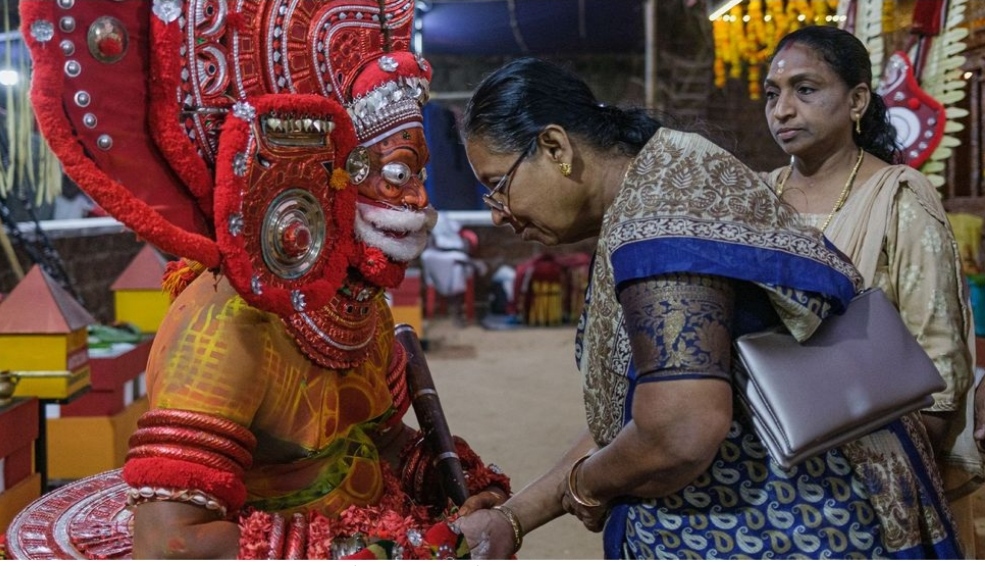Theyyam : The Indian trance where men become gods

(Image credit: Tim Bird)
By Tim Bird
Theyyam is an ancient and mysterious folk ritual, and one of South India’s most mesmerising experiences.
I could hear the staccato drumming rising to a crescendo through the trees, suppressing the chirping of the dawn chorus of birds at 04:30. Descending the steps to the temple, I walked barefoot towards a small crowd of women dressed in their finest saris. Moments later, a performer clothed in an embroidered red dress with intricate orange patterns painted on his face appeared from behind the temple. As an immense crimson, silver-studded crown called a mudi was placed on his head, he began to dance in small, childlike hops as he began his transformation from a mortal into a god.
With nearly 1.5 billion people and 330 million Hindu deities, India has no shortage of religious festivals and performances. Yet one of the most ancient and mesmerising is theyyam, which takes place in the southern state of Kerala and parts of neighbouring Karnataka. Meaning “God” or the “incarnation of God”, theyyam is an ancient folk ritual combining theatre, mime and worship that incorporates Hindu mythology. It harks back to a time when tribal animism reigned supreme and culminates when performers (kolams) adorned with brightly coloured paste and elaborate headdresses dance themselves into a trance-like state as they seek to become the gods they portray.
Today, there are more than 400 different types of theyyams across northern Kerala and Karnataka. These performances are held most nights between dusk and dawn from October to April, with their timing determined in consultation with astrologers who identify auspicious dates using the local Malayalam calendar. While each event is free and open to the public, theyyams aren’t tourist spectacles but sacred and deeply felt shows of history and faith.

Only natural materials are used to make theyyam dyes (Credit: Tim Bird)
The art of theyyam face painting
My first theyyam took place at Panachikkavu, a remote rural temple some 20km inland from the harbour city of Kannur. I arrived early and found artists using the thinnest of brushes to create intricate geometrical face patterns and designs for each performer – a process that can take several hours.
No two Theyyam rituals are identical, and while the painting, garments and accessories vary from character to character, there are certain guidelines. According to theyyam expert PS Kurian, only natural materials are used to make the traditional dyes. Rice paste is used to make white, turmeric for yellow. The dominant colour in theyyam performances is red, which signifies action and energy but also anger, and is achieved with a mixture of turmeric and limestone. Black is produced with rice paddy husk burned and mixed with coconut oil.

Theyyam performers seek to bring spectators closer to the gods they impersonate (Credit: Tim Bird)
Dressing for the occasion
Dressing the participants is also a meticulous process and generally takes place in a private tent or chamber away from the temple. The flamboyant mudi crown is fashioned from lightweight materials such as areca nut, coconut, peacock feathers and shells.
Before each theyyam performer’s passage to entrancement, they engage in a period of abstinence, fasting, prayer and solitary meditation. Their aim isn’t just to transform into the deity portrayed by their character, but also to bring spectators close to their gods by virtue of their impersonation, blurring the lines between humanity and divinity.

Only people from India’s lower Dalit caste may participate in each theyyam (Credit: Tim Bird)
A revered role for a historically “lower” caste
At the start of each theyyam performance I witnessed, the kolam swayed and twirled as the drumbeats built. The rat-a-tat soundtrack of the drummers was interspersed with trumpet blasts that set the pace for the dancer’s facial grimaces, skips and hops.
As Kurian explained, despite the fact that theyyam harks back to an animistic, time, a fundamental element of Hinduism underlines the performance: the caste system. “Only members drawn from 15 specific Dalit low-caste groups [there are hundreds of Dalit groups in India] – and only males may participate in the theyyam’s enactment,” he said. “Those drummers are from the very lowest caste of Dalits.” In an inversion of prevalent social norms, the Dalit participants are treated with rare, even revered respect by attendees from higher castes.

Even female gods are portrayed by male actors (Credit: Tim Bird)
A sacred ritual for men and women
Some theyyams are much longer than others, with the longest events starting at dusk and continuing until dawn. Before dawn one morning, I found myself at another temple near Kannur, watching two white-faced Gulikan characters, twin incarnations of Yama, the Hindu god of death and justice, dance and spin into a trance.
Because theyyam is a male-dominated event, even female gods are portrayed by male characters. Yet, Kurian told me there is a single exception: a snake temple near the town of Alleppey, where a woman performs a theyyam ritual once every two years. Otherwise, women are eager attendees, turning up in their best saris to seek post-ritual blessings and whispered counselling from the kolam. Traditionally, performers learn the craft and its spiritual significance from their fathers in a familial tradition spanning centuries.
Between theyyam performances, I visited the Kallikkodan family, whose matrilineal ancestral home is in the compound of a kaavu, or small temple, in Kannur. “Women perform meticulous and important preparations at the temple when theyyams are held,” explained Nandana Rajesh, adding that her mother, Sadhya, and grandmother, Sujana, supply the different materials for the priest and his assistants. “We know that the theyyams are traditionally performed only by men and we accept it. It’s tradition.”
“For us, the theyyam is not just a ritual; it’s a powerful art form that gives us great energy as well as blessings from the gods,” said VS Simi, a Kerala resident. “The great stories of Kerala are often retold using art forms including the theyyam,” added Lakshmi Vijayan, another Kerala native. “It is how our ancient legends truly come to life.”

The “mudi” headpiece plays a significant role in theyyam (Credit: Tim Bird)
A fearsome crimson apparition
Traditionally, each temple is devoted to certain theyyam variations, involving different gods and characters, in addition to the central kolam characters. While animist and Hindu narratives are commonly merged in each ritual, Hindu characters and stories often take centre stage. These might include Hanuman (the monkey god), or the representation of Shiva (the Hindu deity of fertility and destruction) in the form of Gulikan, identified by its white mask and towering areca palm-leaf headpiece.
Yet, the most dramatic and distinctive characters are the dominant, frowning, crimson apparitions of the kolams, clothed in a broad hooped skirt and crowned with the massive, imposing mudi headpiece.

The kolam tradition is typically passed from father to son (Credit: Tim Bird)
A spiritual sacrifice
Fire plays a big part in theyyams, representing a spiritual gateway as well as a cleansing substance. Walking on or diving into fire in a theyyam might also be the re-creation of an event from Hindu mythology.
One day, Kurian and I visited Shaiju, a theyyam dancer in his Kannur home. When he opened the door, I noticed burn marks on his nose and chin. He explained that these scars were from the Thee Chamundi version of theyyam, when the kolam, dressed in a skirt of coconut leaves, flings himself face-first into a pile of red-hot embers dozens of times in a single performance. Thee Chamundi portrays how Lord Vishnu’s devotee, Prahlad, is repeatedly plunged into fire by a vengeful demon.
“I started my theyyam career at the age of five,” Shaiju said, explaining that he learned to become a kolam from his father. He took me inside the house, posing like a prize boxer to present his shelves of theyyam shields and trophies. “My first performance was as Adivedan, a theyyam performed by young boys at the time of the Onam harvest festival celebrated all over Kerala, by all religions and all classes. Now, I am able to perform 12 characters. I was honoured by the Azheekode Njhezhoor temple after performing Thee Chamundi there. I was presented the golden bangle and the red silk cloth which I keep in my private puja (prayer) room as my most sacred possession.”

Certain theyyam performances involve plunging oneself into burning embers (Credit: Tim Bird)
Head-first into the fire
Several days after visiting Shaiju, I went to another temple to witness the Thee Chamundi. A roaring blaze crackled in front of the shrine, and priests and attendants fanned the embers, sprinkling the surroundings with water to control the fire and prevent it from spreading. The kolam was led into the arena, cloaked in a suit of green coconut leaves. As he rushed face-first onto the embers, sparks flew, smoke billowed and the crowd cried out, urging him on. The assistants quickly dragged him clear, his coconut-leaf skirt charred and smouldering. But within a minute or so, he was taking the plunge, again and again and again.
Stunned, overwhelmed and somewhat entranced myself, I headed back to my guesthouse under a fiery sunrise as the feverish drums faded into the distance.
Source: BBC Travel



